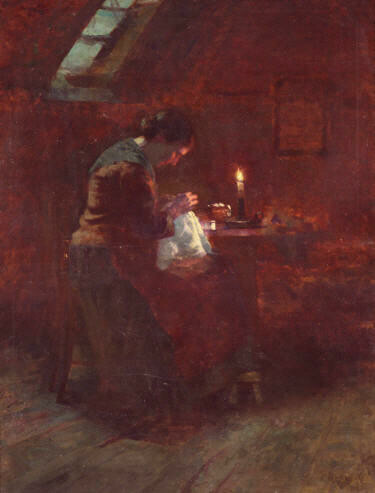Charles Herbert Eastlake
British, b.1868, d.1940
With Fingers Weary And Worn
- 1892
- Oil on canvas
- Presented by the Canterbury Society of Arts, 1932
- 1270 x 1020mm
- 69/390
Tags: attics (interior spaces), candles, chairs (furniture forms), interior, needlework (visual works), people (agents), sewing (needleworking techinique), tables (support furniture), textiles (visual works), windows, women (female humans), workers
Brought to light, November 2009- 22 February 2011
‘With fingers weary and worn’ is the first line of Thomas Hood’s 1843 poem ‘The Song of the Shirt’, which tells of the harsh conditions faced by many women in the garment industry of Victorian England, who worked day and night for meagre pay. Eastlake’s strongly moral painting portrays the exploitation of the women by visually interpreting Hood’s narrative. With fingers weary and worn, With eyelids heavy and red, A woman sat, in unwomanly rags Plying her needle and thread – Stitch! stitch! stitch! In poverty, hunger, and dirt.
Exhibition History
First exhibited at the Royal Academy, London, in 1892, this painting takes its inspiration from Thomas Hood’s well known poem of 1843 “The Song of the Shirt”. The darkly dressed woman shown hunched over her stitching in a drab, poorly-lit attic room illustrates these lines from Hood’s poem: “With fingers weary and worn With eyelids heavy and red A woman sat in unwomanly rage Plying her needle and thread. Stitch, stitch, stitch! In poverty hunger and dirt.”
Narrative paintings like this with their strong moralising or social theme were common in the early 19th century and were aimed at the middle class conscience.
With Fingers Weary and Worn probably travelled to New Zealand for the 1906 New Zealand International Exhibition in which Charles Eastlake and his wife, who was also an artist, exhibited seven works. In 1909 there was a solo exhibition of Charles Eastlake's paintings at the Canterbury Society of Arts. It is possible that the Eastlakes may have visited Christchurch around this time during a short visit to New Zealand. In 1939 however, they emigrated to Canada, which was Mrs Eastlake's place of birth.
With Fingers Weary and Worn remains in this collection as an interesting example of Victorian narrative painting which makes a social commentary. (Label from before 2003)

